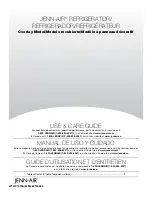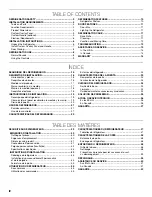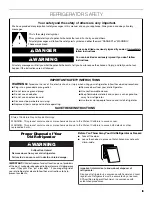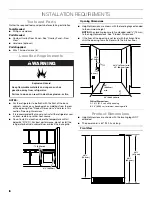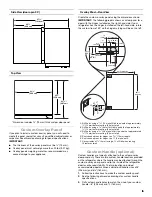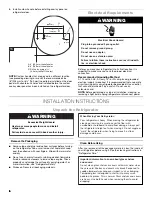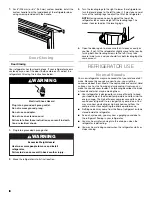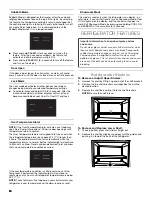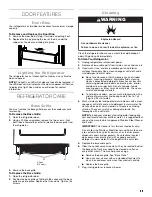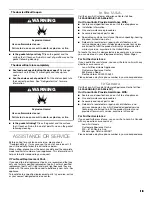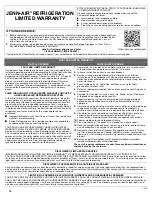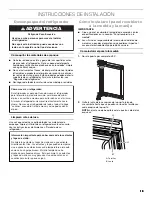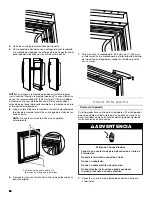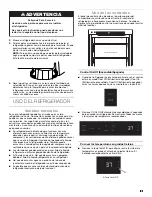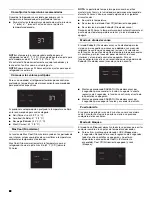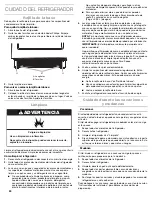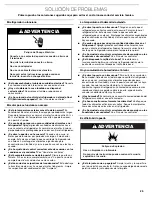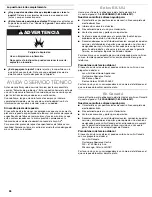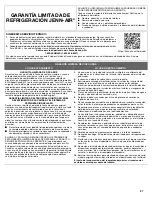
12
12
12
Vacation and Moving Care
Vacations
If you choose to leave the refrigerator on while you’re away, use
up any perishables and freeze other items.
If you choose to turn the refrigerator off before you leave, follow
these steps.
1.
Remove all food from the refrigerator.
2.
Unplug the refrigerator.
3.
Clean the refrigerator. See “Cleaning.”
4.
Tape a rubber or wood block to the top of the door to prop it
open far enough for air to get in. This stops odor and mold
from building up.
Moving
When you are moving your refrigerator to a new home, follow
these steps to prepare it for the move.
1.
Remove all food from the refrigerator.
2.
Unplug the refrigerator.
3.
Clean, wipe, and dry it thoroughly.
4.
Take out all removable parts, wrap them well, and tape them
together so they don’t shift and rattle during the move.
5.
Tape the doors shut and tape the power cord to the back of
the refrigerator.
When you get to your new home, put everything back and refer to
the “Installation Instructions” section for preparation instructions.
TROUBLESHOOTING
Try the solutions suggested here first in order to avoid the cost of an unnecessary service call.
Your refrigerator will not operate
■
Is the power supply cord unplugged?
Plug into a grounded
3 prong outlet.
■
Has a household fuse blown, or has a circuit breaker
tripped?
Replace the fuse or reset the circuit.
■
Is the Refrigerator Control in Cool Off mode?
See “Using
the Controls.”
The motor seems to run too much
■
Is the temperature outside hotter than normal?
Expect the
motor to run longer under warm conditions. At normal
outdoor temperatures, expect your motor to run about 40%
to 80% of the time. Under warmer conditions, expect it to run
even more of the time.
■
Has a large amount of food just been added to the
refrigerator?
Adding a large amount of food warms the
refrigerator. It is normal for the motor to run longer in order to
cool the refrigerator back down.
■
Is the door opened often?
Expect the motor to run longer
when this occurs. In order to conserve energy, try to get
everything you need out of the refrigerator at once, keep food
organized so it is easy to find, and close the door as soon as
the food is removed.
■
Is the control set correctly for the surrounding
conditions?
See “Using the Controls.”
■
Is the door closed completely?
Push the door firmly shut. If
it will not shut all the way, see “The door will not close
completely” later in this section.
■
Are the condenser coils dirty?
This obstructs air transfer
and makes the motor work harder. Clean the condenser coils.
See “Cleaning.”
Temperature is too warm
■
Is the door opened often?
Be aware that the refrigerator will
warm when this occurs. In order to keep the refrigerator cool,
try to get everything you need out of the refrigerator at once,
keep food organized so it is easy to find, and close the door
as soon as the food is removed.
■
Has a large amount of food just been added to the
refrigerator?
Adding a large amount of food warms the
refrigerator. It can take several hours for the refrigerator to
return to the normal temperature.
■
Is the control set correctly for the surrounding
conditions?
See “Using the Controls.”
■
Is the base grille blocked?
For best performance, do not
install the refrigerator behind a cabinet door or block the base
grille.
There is interior moisture buildup
■
Is the door opened often?
To avoid humidity buildup, try to
get everything you need out of the refrigerator at once, keep
food organized so it is easy to find, and close the door as
soon as the food is removed. When the door is opened,
humidity from the room air enters the refrigerator. The more
often the door is opened, the faster humidity builds up,
especially when the room itself is very humid.
■
Is it humid?
It is normal for moisture to build up inside the
refrigerator when the air is humid.
■
Is the food packaged correctly?
Check that all food is
securely wrapped. Wipe off damp food containers before
placing in the refrigerator.
■
Is the control set correctly for the surrounding
conditions?
See “Using the Controls.”
Electrical Shock Hazard
Plug into a grounded 3 prong outlet.
Do not remove ground prong.
Do not use an adapter.
Do not use an extension cord.
Failure to follow these instructions can result in death,
fire, or electrical shock.
WARNING

